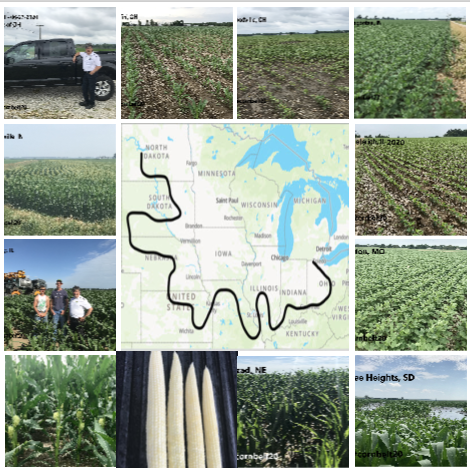Hot and humid temperatures with a heat index close to 100F are having an impact!
The USDA says that the portion of the U.S. corn crop that is in ‘good to excellent condition’ is about 73%, with ‘poor to very poor’ conditions reported only for about 5% of the corn crop. USDA also reports that corn silking is at 4% vs. 7% average for this point in the growing season.
By contrast the USDA says soybeans are 14% blooming vs. the average of 11% for this point in the growing season, and soybean conditions are 71% good to excellent and 5% of soybean crops is poor to very poor.
However, the USDA does not report on the size of either the corn or the soybean plants. Moe Agostino, Chief Commodity Strategist, Farms.com Risk Management and host of the 2020 9th Annual U.S. Corn Belt Crop Tour has completed 9 days out of a total of 19 days and travelled through 7 out of 12 U.S. Midwest states from June 27th – July 5th, 2020. Agostino reports that the corn and soybean plants that he has seen so far on his tour are anywhere from 1 to 4 weeks behind in terms of plant size for this time of year.

Agostino has travelled through southern Indiana, north into central Illinois and then south again in that state. He then travelled west into Missouri and Kansas before heading North again into Nebraska and South Dakota.
The Commodity Strategist reports that he has encountered a rainstorm every day of the tour so far, and that it has been hot and humid with temperatures and the heat index close to 100F, even in the Western Corn Belt.
“Over the nine years I have conducted the tour, I have never witnessed 100-degree temperatures this early on tour, as we would normally have to wait until Kansas or the Western Corn Belt to have temperatures this high. The weather does not seem right?”
Agostino says, “there seems to be a lot of ‘haves’ and ‘have nots’ with more ‘haves’ so far and conditions have held for now.” Agostino indicates the pendulum could be swinging to more ‘have nots’ as the growing season unfolds and the weather turns hot and dry in July. Very little precipitation is in the forecast for the first half of the month.
The 2020 planting season began earlier than 2019, but it was not ideal with many farmers interviewed during the tour reporting that it was cold and wet. Some farmers were hit with frost the 1st week of May and it did not turn hot and dry until June. Despite this challenge, all acres were planted, so there will be less prevent plant acres vs. 2019. This resulted in short and delayed corn crops by July 1 and in some cases the soybean plants are higher than corn because the farmer could not plant corn, and so decided to plant soybeans earlier as they are less susceptible to cold weather.
Despite the heat, the timely rains have created lush, green heathy crops with no soil moisture or crop/disease stress in many areas, but there was moisture stress in central South Dakota (Brown County), some weed pressure in Nebraska and ‘pineapple’ corn in Kansas showing heat stress.
Often considered the “garden spot” by the industry, Agostino reports that the Western Corn Belt is not much better than the Eastern Corn Belt, other than in Nebraska. In fact, in North Dakota, despite challenges planting, the crops are looking good for the most part and 60F nighttime weather and 80F daytime weather is perfect corn growing weather.
Agostino reports that “corn plants are much shorter than I expected for this time of the year with a lot more ankle high corn than I was expecting in Ohio, Indiana, and Illinois. In 2019, the commodity trade was worried about short soybean plants and in 2020 they will need to get worried about both short corn and soybean plants.”
The soybean plant growth has been stunted by the heat and lack of rainfall in many regions. Less than 1% of corn and soybean acres were canopied by the longest day of the year June 21, 2020!
Despite the observations thus far, Agostino says yield potentials remains strong if good conditions can be maintained.
Follow the 9th Annual U.S. Corn Belt Crop Tour on Twitter @FarmsMarketing #cornbelt20.
For more information about Farms.com Risk Management, visit: https://riskmanagement.farms.com/.